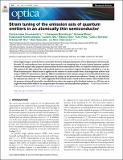Strain tuning of the emission axis of quantum emitters in an atomically thin semiconductor
Author(s)
Chakraborty, Chitraleema; Moon, Hyowon; Englund, Dirk R.
DownloadPublished version (1.839Mb)
Publisher Policy
Publisher Policy
Article is made available in accordance with the publisher's policy and may be subject to US copyright law. Please refer to the publisher's site for terms of use.
Terms of use
Metadata
Show full item recordAbstract
Strain engineering is a natural route to control the electronic and optical properties of two-dimensional (2D) materials. Recently, 2D semiconductors have also been demonstrated as an intriguing host of strain-induced quantum-confined emitters with unique valley properties inherited from the host semiconductor. Here, we study the continuous and reversible tuning of the light emitted by such localized emitters in a monolayer tungsten diselenide embedded in a van der Waals heterostructure. Biaxial strain is applied on the emitters via strain transfer from a lead magnesium niobate-lead titanate (PMN-PT) piezoelectric substrate. Efficient modulation of the emission energy of several localized emitters up to 10 meV has been demonstrated on application of a voltage on the piezoelectric substrate. Further, we also find that the emission axis rotates by ∼ 40◦ as the magnitude of the biaxial strain is varied on these emitters. These results elevate the prospect of using all electrically controlled devices where the property of the localized emitters in a 2D host can be engineered with elastic fields for an integrated opto-electronics and nano-photonics platform.
Date issued
2020-06Department
Massachusetts Institute of Technology. Research Laboratory of Electronics; Massachusetts Institute of Technology. Department of Electrical Engineering and Computer ScienceJournal
Optica
Publisher
The Optical Society
Citation
Chakraborty, Chitraleema et al. “Strain tuning of the emission axis of quantum emitters in an atomically thin semiconductor.” Optica, 7, 6 (June 2020): 2334-2536 © 2020 The Author(s)
Version: Final published version
ISSN
2334-2536